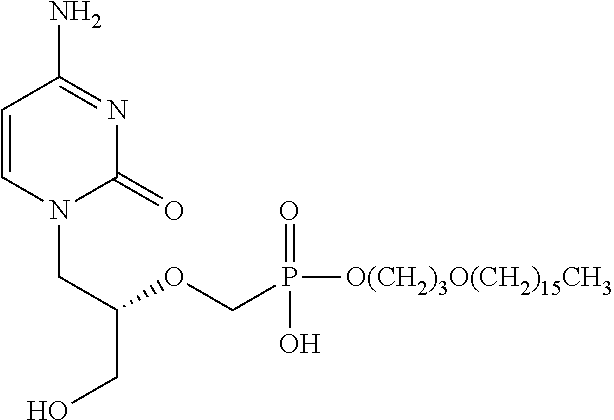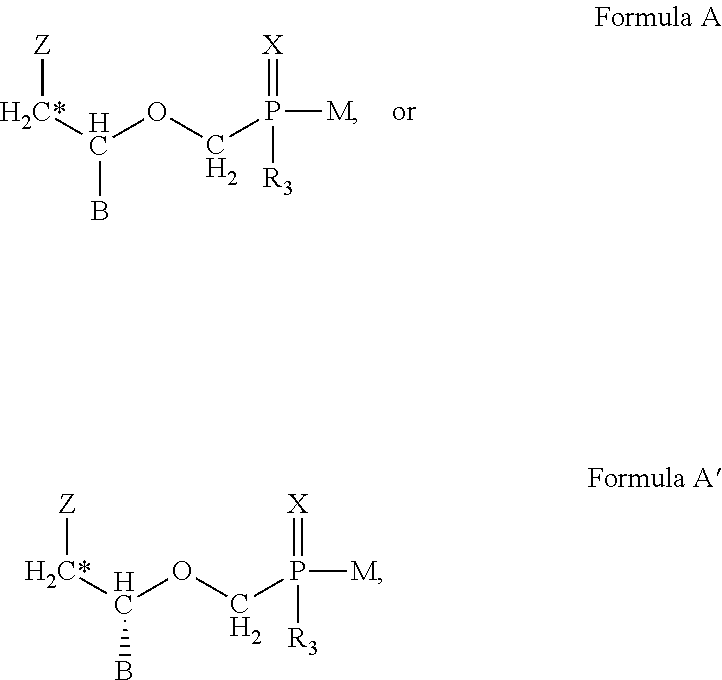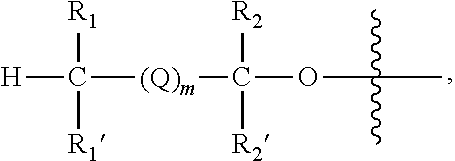Methods of treating orthopox virus infections and associated diseases
a technology of orthopox virus and associated diseases, applied in the field of methods of treating orthopox virus infections and associated diseases, can solve the problems of affecting the treatment effect of patients with weakened immune systems, e.g., hiv infection, transplantation, chemotherapy for cancer treatment, etc., and achieve the effect of improving the quality of life, improving the treatment effect, and improving the treatment
- Summary
- Abstract
- Description
- Claims
- Application Information
AI Technical Summary
Benefits of technology
Problems solved by technology
Method used
Image
Examples
example 1
[0150]The antiviral activity of CMX001 has been characterized against orthopoxviruses in vitro and in vivo in mice, rabbits, and non-human primates. The in vitro potency of CMX001 against variola virus is 0.1 μM and ranges from 0.5 to 0.9 μM against cowpox, vaccinia, ectromelia, and rabbitpox viruses (Hostetler, 2009). In mice, CMX001 is effective in preventing mortality after intranasal infection with a lethal inoculum of ectromelia, cowpox, vaccinia, or monkeypox virus when administered several days after infection. Effective doses are in the range of 1 mg / kg to 20 mg / kg once per day for 5 days. Alternatively, a single dose of 20 mg / kg to 100 mg / kg is effective in some cases. In the rabbit model, CMX001 is also effective in preventing mortality after a lethal infection with rabbitpox virus. Effective doses ranged from 1 mg / kg twice daily for 5 days to 20 mg / kg once daily for 5 days. A single dose of 20 mg / kg dose is also effective in some cases. In a recent randomized, blinded, pl...
example 2
[0152]Progressive vaccinia (PV), previously known as vaccinia necrosum, vaccinia gangrenosum, or disseminated vaccinia, is a rare, often fatal adverse event after vaccination with smallpox vaccine, made from live vaccinia virus. During recent vaccination programs potential cases of PV were investigated, but none met standard case definitions. PV has not been confirmed to have occurred in the United States since 1987. On Mar. 2, 2009, a U.S. Navy Hospital contacted the Poxvirus Program at CDC to report a possible case of PV in a male military smallpox vaccinee. The service member had been newly diagnosed with acute mylegenous leukemia M0 (AML M0). During evaluation for a chemotherapy-induced neutropenic fever, he was found to have an expanding and nonhealing painless vaccination site 6.5 weeks after receipt of smallpox vaccine. Clinical and laboratory investigation confirmed that the vaccinee met the Brighton Collaboration and CDC adverse event surveillance guideline case definition ...
example 3
[0165]A study was completed to determine whether CMX001 is a substrate of human Organic Anion Transporter 1 (hOAT1) and hOAT3 using cell-based methods.
[0166]Cidofovir (CDV) is a polar, acyclic nucleoside phosphonates that is FDA-approved as Vistide® (cidofovir injection) for the treatment of cytomegalovirus retinitis. CMX001 has demonstrated increased potency in cell based assays relative to CDV and has proven effective in vivo in animals after oral administration. Importantly, no signs of nephrotoxicity have been observed in animal toxicology studies or in human clinical trials to date after oral administration of CMX001, a distinct advantage compared to CDV, which is known to accumulate in kidney proximal tubule cells through their selective uptake by organic anion transporter 1 (OAT1) and OAT3.
Method
[0167]Cellular uptake. MDCK-II cells were grown on semi-permeable filters (1 μM, polyethylene terephthalate (PET), Millipore), and transiently transfected with hOAT1, hOAT3 or vector ...
PUM
| Property | Measurement | Unit |
|---|---|---|
| particle sizes | aaaaa | aaaaa |
| particle sizes | aaaaa | aaaaa |
| particle sizes | aaaaa | aaaaa |
Abstract
Description
Claims
Application Information
 Login to View More
Login to View More - R&D
- Intellectual Property
- Life Sciences
- Materials
- Tech Scout
- Unparalleled Data Quality
- Higher Quality Content
- 60% Fewer Hallucinations
Browse by: Latest US Patents, China's latest patents, Technical Efficacy Thesaurus, Application Domain, Technology Topic, Popular Technical Reports.
© 2025 PatSnap. All rights reserved.Legal|Privacy policy|Modern Slavery Act Transparency Statement|Sitemap|About US| Contact US: help@patsnap.com



